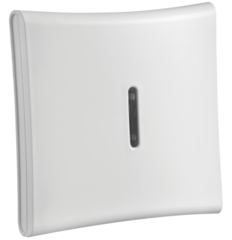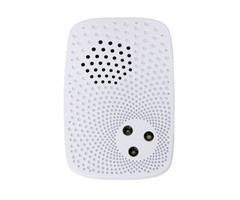The Benefits of PowerG Sensors
Posted By Michael GorisYou have likely heard us talking about the benefits of PowerG Sensors at one point or another. Today, we figured we would break down the benefits of these sensors and explain why we like them so much. Let's take an in-depth look at PowerG Sensors and all of their wonderful benefits.

PowerG Sensors were originally designed for the hardwired DSC PowerSeries NEO Systems. By adding a compatible transceiver unit to your PowerSeries NEO, the system will be able to support PowerG Sensors. Johnson Controls, which you may know as the parent company of DSC, took the technology associated with PowerG Sensors, and brought it over to the Qolsys IQ Panel 2 System. This move was not a major surprise, as Johnson Controls also had partial ownership over Qolsys at the time, and Johnson Controls has since bought out Qolsys entirely.
The addition of PowerG support for the IQ2 marked the beginning of the Qolsys IQ Panel 2 Plus, which is how the system is still marketed and sold today. PowerG support is also available for the DSC Iotega, though that panel has largely flopped due to its lack of local end user programming. Today, the Qolsys IQ Panel 2 Plus represents the most popular panel for supporting PowerG. All versions and variants of the IQ Panel 2 Plus support PowerG Sensors, and their exceptional performance makes them the go-to choice for IQ2+ users who want equipment with the best versatility and protection.
Starting with the range, PowerG Sensors can be used from up to 2,000 feet away from the IQ Panel 2 Plus when they are used in an open air environment. By open air environment, we are talking about a perfect setting with a direct line of sight, and no obstacles between the sensor and the alarm panel. Most homes and businesses do not provide the ideal, "open air" environment, as there are usually walls and metal appliances present. When you see us mention that 2,000 feet open air range, take that with a grain of salt, because in practice, the range is likely a bit less. But still, we can undoubtedly say that PowerG offers arguably the best wireless range in the security industry. Even if its nominal range isn't quite as far as its "open air range", it is still a very powerful signal that can help you overcome the range issues that other sensor lineups may experience. It is great for use in detached garages, barns, multi-building complexes, and even just large industrial buildings.

To make matters even better, there is also a PowerG Repeater, the PG9920. This device will effectively double the range of any PowerG Sensor and help you overcome range limitations caused by thick walls and other obstacles or signal disruptions. The repeater works by taking the signal sent out from any PowerG Sensor and sending it out a second time with just as much power and force as when it was first sent from the original sensor. By strategically placing the repeater, it's theoretically possible to double the useful wireless range of these sensors. That would mean that they can be used from up to 4,000 feet away from the IQ2+ in an open air environment. And if your building is particularly large, you may even have repeaters going away from the IQ Panel 2 Plus System in different directions, including up and down in building stories above or below.
But PowerG Sensors offer more than just an impressive wireless range. They are also known for their exceptional security. This is thanks to their military grade 128-bit AES encryption. To put this as simply as possible, the PowerG Sensor and the panel share a unique encryption key at the time of pairing. The sensor must provide this encryption key to the panel whenever it transmits a signal. Additionally, the panel must then provide a return response with the encryption key as verification in order for the command to go through. In the past, we have referred to this two-way communication process as a "digital handshake". Because of this encrypted pairing process, a PowerG Sensor actively knows whether or not it is currently paired with a panel. You may need to factory default a PowerG Sensor before you can pair it with a new system.

PowerG Sensors also take proactive measures against RF jamming. When a wireless sensor communicates with an alarm panel, it does so at a certain wireless radio frequency (RF). When we talk about RF jamming, we are referring to any malicious technique that prevents wireless signals from reaching their intended destination. This is accomplished by blocking the receiver with a stronger signal at the same wireless frequency as the device that is legitimately trying to communicate with it. When this is done on an alarm system, the system doesn't receive the incoming signals from faulted sensors, and no action is taken during a security breach or an unfavorable environmental condition. Early wireless sensors did not take this into account, and this made RF jamming an effective way to defeat an older wireless system.
The way that PowerG Sensors overcome RF jamming techniques is through a process called Frequency Hopping Spread Spectrum (FHSS). This process involves splitting the RF bandwidth into multiple channels. Each independent channel represents a unique radio frequency for wireless communication to occur. The transmitter (the PowerG Sensor) and the receiver (the alarm panel) both agree on a set of channel hopping sequences that will take place. These sequences are encrypted and time-based for them to occur seamlessly. Since the transmitter and the receiver are both synchronized, they can switch between channels very rapidly. A potential intruder would never be able to re-tun an RF jamming device to keep up. In the case of the PowerG Sensors, the frequency hops occur between 912 MHz and 918 MHz. There are 50 different unique frequency channels that are used, and frequency switches occur 64 times per second. More information on FHSS is available here.
 One other benefit of PowerG Sensors that we have never discussed previously is their Adaptive Transmission feature that helps them conserve battery life. This is why you will often see a PowerG Sensor with a very long expected battery life, sometimes more than ten (10) years). Adaptive Transmission involves two-way communication between the PowerG Sensor and the alarm panel. The alarm panel will tell the PowerG Sensor how well its signal is being received. The PowerG Sensor can then adapt its outgoing signal so that it reliably reaches the panel, without expending too much energy. The sensor and the panel regularly exchange this information so that the ideal amount of energy is always used in signal transmissions. This saves battery life in the long run.
One other benefit of PowerG Sensors that we have never discussed previously is their Adaptive Transmission feature that helps them conserve battery life. This is why you will often see a PowerG Sensor with a very long expected battery life, sometimes more than ten (10) years). Adaptive Transmission involves two-way communication between the PowerG Sensor and the alarm panel. The alarm panel will tell the PowerG Sensor how well its signal is being received. The PowerG Sensor can then adapt its outgoing signal so that it reliably reaches the panel, without expending too much energy. The sensor and the panel regularly exchange this information so that the ideal amount of energy is always used in signal transmissions. This saves battery life in the long run.
We have also found that PowerG Sensors are extremely easy to enroll and they offer the reliable and effective performance that you should expect out of your security system. We wholeheartedly recommend them for use on the Qolsys IQ Panel 2 Plus, as well as any other compatible alarm system. It is expected that the upcoming Qolsys IQ Hub will also be able to utilize PowerG Sensors, so look forward to using PowerG Sensors on that panel once it is available.

For now, if you have any questions about PowerG Sensors or the systems that support them, or if you are interested in signing up for new alarm monitoring service, then please reach out to us by emailing support@alarmgrid.com. We'll be available to check your emails from 9am to 8pm ET M-F. We look forward to hearing from you!









